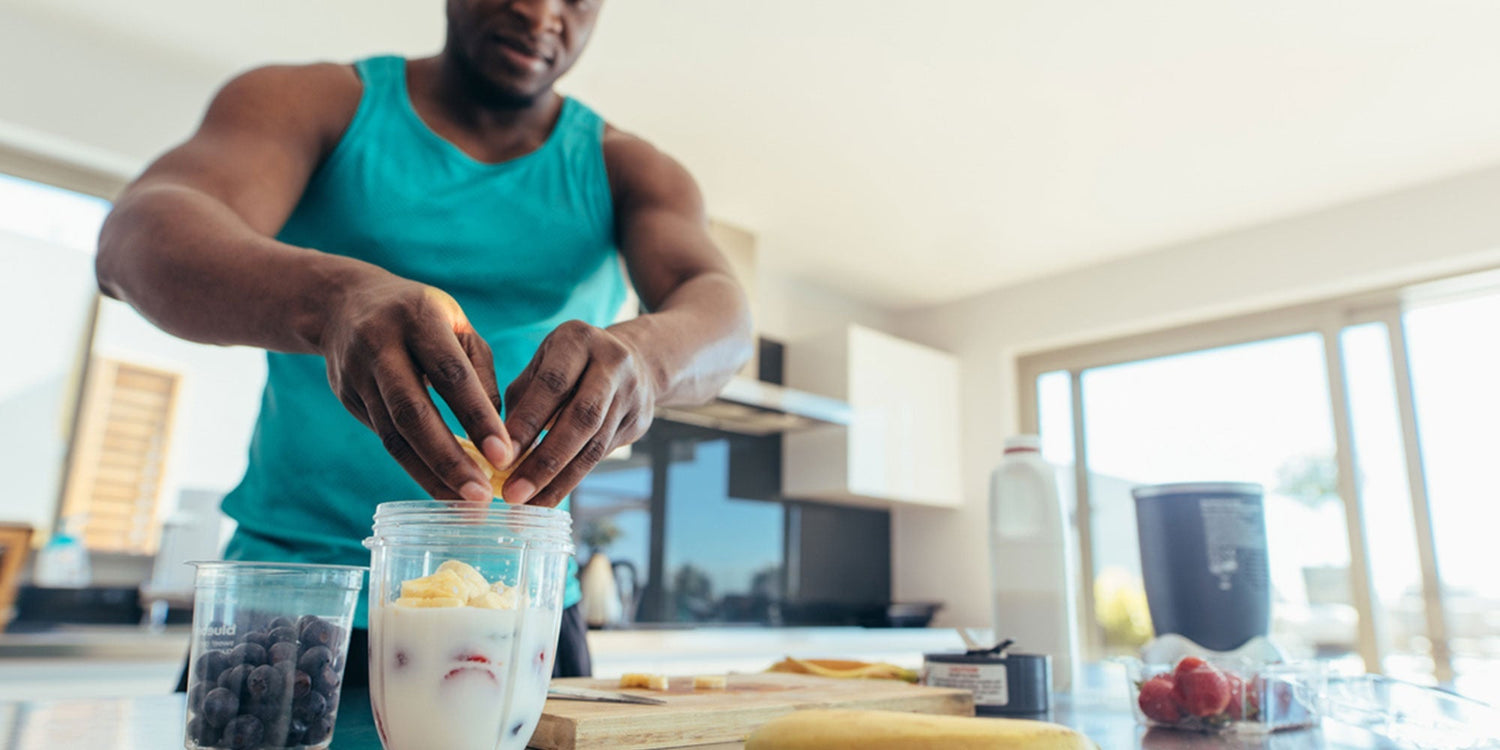The Answer: Yes, you can blend creatine without destroying its effectiveness. It remains stable in blenders, hot liquids, smoothies, and oats. Myths about breakdown from heat or mixing are false, creatine monohydrate stays potent for hours and works well in both simple and complex recipes.
Blending creatine shouldn’t feel like a chemistry experiment.
You’re not trying to preserve a fragile compound, you’re just trying to build muscle, boost performance, and get on with your day.
Yet somehow, this simple question, can you put creatine in a blender?, still stirs up confusion.
Some claim heat destroys it. Others think blending “activates” it. A few still believe it has to be taken immediately after mixing or it turns into useless sludge.
None of that holds up.
Creatine monohydrate is one of the most stable, science-backed supplements in existence. It works because it’s simple, and it stays effective in the real world, whether you toss it in a shaker or blend it into a thick banana-oat smoothie.
Why People Ask This Question in the First Place
For a supplement as well-studied as creatine, it still manages to generate an unusual amount of confusion, especially around how it should be taken.
Most of that confusion comes from a mix of outdated science, anecdotal hearsay, and a lot of noise from supplement forums that often blur fact with speculation.
A common concern is that creatine might "break down" when exposed to mechanical stress or heat.
This idea likely comes from the fact that creatine can degrade into creatinine over time in acidic solutions or when left mixed in liquid for extended periods, especially in citrus juices.
But people have extended that logic to believe that a few seconds in a high-speed blender or a warm cup of coffee might neutralize its effects. It doesn’t.
Another worry is about residue.
Users often report that creatine clings to the inside of thick smoothie jars or settles at the bottom of a shaker bottle, leading to the impression that some of it is wasted. Others claim that thicker blends, especially those with oats or frozen fruit, reduce creatine’s absorption or slow digestion.
These ideas persist mostly because there’s a lack of clear, consistent guidance from mainstream sources.
Without well-designed studies answering every niche scenario, frozen blueberries versus warm oats, shaker bottle versus Nutribullet, people fall back on guesswork.
That’s how blending myths get passed around, and why the simple act of mixing creatine into your breakfast shake ends up being a topic of debate.
The Truth About Creatine’s Stability
Creatine has a reputation for being delicate, but science tells a different story.
It’s one of the most stable, resilient compounds in sports nutrition. The panic around blending or heating creatine is mostly fueled by misunderstandings, outdated studies, and misapplied chemistry.
Let’s get one thing straight, creatine doesn’t fall apart because you put it in a blender or add it to a warm drink. Its structure holds up just fine under normal use, and that includes being tossed into a smoothie or stirred into your morning coffee.
Does Blending Creatine Destroy It?
No, mechanical blending does not break creatine down.
It isn’t some fragile molecule that falls apart on contact with a blender blade. Chemically speaking, creatine is stable in water-based solutions for hours.
Most forms retain over 95% of their potency for at least 8 hours after being mixed with liquid, long enough to prep your shake in the morning and drink it later with zero worry.
So where do the concerns come from?
Some confusion stems from creatine’s known instability in acidic environments. Left too long in citrus juice, creatine can degrade into creatinine, a waste product with no performance benefit.
But that requires time and low pH, not a blender or a scoop in your oatmeal.
Heat? Also not a problem.
Studies have shown creatine remains structurally sound even at high temperatures used in cooking.
What About Mixing with Smoothies, Oats, or Coffee?
Yes, you can add creatine to all of the above.
It dissolves faster in warm liquids like coffee and doesn’t degrade from the heat.
Thick smoothies or oats are equally fine, just be mindful of blending technique. Creatine can stick to the sides of blenders or clump if not dispersed well, so use micronized powder and blend thoroughly.
As for absorption, denser blends might delay digestion slightly, but they don’t block effectiveness. It’s still creatine, and it still works.
Practical Tips for Mixing Creatine Effectively
Creatine is easy to use, but getting the most out of it means paying attention to how you prepare it.
Whether you’re tossing it into a post-workout shake or a breakfast smoothie, the goal is simple: dissolve it well, avoid waste, and make sure it fits your routine.
Below are practical considerations to help you get the best results, without overcomplicating your stack.
Blending vs. Shaking: Which is Better?
There’s no meaningful difference in creatine’s effectiveness between a blender and a shaker.
Chemically, it’s the same result. But in terms of real-world experience, the two methods offer different advantages.
Blending gives you better flavor, texture, and flexibility, you can combine oats, bananas, nut butter, or protein powder and end up with a smooth, satisfying shake that can double as a meal. This is especially useful for those using creatine to support muscle gain or recovery.
Shaker bottles win on convenience.
Less cleanup, fewer moving parts, and perfect for people who just want to mix creatine with water or juice and be done with it. Both methods work, but your choice should reflect your lifestyle. If satiety, habit-building, or digestion timing matter to you, blending may be worth the extra step.
Avoiding Residue Loss in Blenders
One legitimate concern is creatine sticking to the walls of thick smoothies, especially when using frozen fruit, nut butters, or oats.
That residue can cost you part of your dose.
To prevent it, use a spatula to scrape the sides or rinse your blender cup with a small amount of liquid and drink it down. If you’re strict about dosing, consider adding an extra half gram to account for what might be lost.
Using micronized creatine also helps, it dissolves faster, clumps less, and integrates smoothly into thicker blends.
What Can You Mix Creatine With?
One of creatine’s biggest strengths, aside from its impact on performance, is its versatility.
It’s nearly flavorless, dissolves well in most liquids, and plays nicely with both foods and other supplements. Whether you’re keeping it simple or stacking for results, creatine adapts to your routine without forcing you to overthink it.
Compatible Liquids and Foods
Creatine can be mixed with just about anything water-based.
The basics: water, milk (dairy or plant-based), coffee, juice, or any kind of smoothie. Hot or cold, it holds up. You’ll get quicker dissolution in warm liquids like coffee, which can also help mask the texture if you’re using non-micronized powder.
Note: In our article, What Can You Mix Creatine With, we discuss how you may not want to mix creatine and coffee. There is no “correct” answer to this question. Consider the pros and cons, then choose for yourself.
If you prefer real-food blends, creatine fits right in with common smoothie ingredients, whey protein, oats, banana, nut butter, cocoa, cinnamon.
Unflavored creatine works best if you’re mixing with other strong flavors; it won’t clash with whatever else is in your cup.
As for timing, consistency is more important than precision.
Creatine’s effects are cumulative, so whether you take it in the morning, post-workout, or even at night, it doesn’t make a big difference, as long as you hit your daily dose.
Supplements You Can Stack Creatine With
Creatine is a team player. You can stack it with protein powder, BCAAs, pre-workouts, or simple carbs without any issues.
In fact, taking creatine with carbohydrates post-workout may improve uptake by increasing insulin activity, supporting glycogen replenishment and muscle recovery.
And despite persistent myths, caffeine doesn’t cancel out creatine’s effects.
There's no evidence of a negative interaction, just be sure to stay hydrated, since both compounds affect water balance.
That makes smoothies or shakes with hydrating ingredients (like fruit, yogurt, or almond milk) a smart combo. Creatine works better when your cells are well hydrated, and real food helps reinforce that.
Can You Make Creatine Taste Good?
Creatine is nearly tasteless on its own, but that doesn’t mean every mix goes down easy.
In plain water, some people notice a slight chalkiness or mineral aftertaste, especially with lower-grade or unmicronized powders. But once you blend it into the right ingredients, it becomes virtually undetectable.
If you’re someone who struggles with texture or flavor, the solution isn’t to avoid creatine, it’s to mix smarter.
The easiest way to enjoy creatine is by building it into a smoothie that supports your nutrition goals and masks any residual grittiness. Here are a few proven combos that taste great and deliver real fuel:
Creatine Smoothie Recipes That Actually Taste Great
1. Banana-Oat Power Shake
-
1 scoop creatine
-
1 banana
-
½ cup rolled oats
-
1 tbsp peanut butter
-
1 tsp cinnamon
-
1 cup unsweetened almond milk
This shake offers sustained energy and makes a great breakfast or mid-morning fuel. The oats help with satiety, while the banana and cinnamon mask any texture from the creatine.
2. Post-Workout Berry Bomb
-
1 scoop creatine
-
1 scoop whey protein (vanilla or berry)
-
½ cup frozen mixed berries
-
½ cup Greek yogurt
-
1 tsp honey
-
¾ cup water or almond milk
This one’s ideal after training. It delivers quick-digesting protein, antioxidants, and carbs to replenish glycogen, all with a refreshing berry kick.
3. Cold Brew Kickstart
-
1 scoop creatine
-
½ cup cold brew coffee
-
1 scoop chocolate whey protein
-
½ cup almond milk
-
Ice cubes
Perfect for early mornings or afternoon lifts. The coffee gives a caffeine boost, while the chocolate protein balances out the bitterness and gives it a mocha flavor.
Meal Prep Options
Creatine’s heat stability opens the door for even more flexibility.
You can mix it directly into pancake or waffle batter, just make sure the powder is fully dissolved in the wet ingredients before cooking to avoid clumping.
For a quick breakfast, stir creatine into overnight oats or add it to hot oatmeal just before eating. No degradation, no drama.
You can also freeze blended shakes ahead of time. Creatine remains effective after freezing and thawing, making this a convenient option for busy days.
Just give the shake a good stir or shake after defrosting to redistribute any settling. Taste, performance, and prep-friendly convenience, all in one.
Yes, You Can Blend Creatine, And You Probably Should
Creatine doesn’t fall apart in a blender, and it doesn’t lose power in your coffee or oatmeal.
It’s a stable compound that works whether you shake it, stir it, or blend it into a smoothie with half your pantry. If anything, mixing creatine with real food or drinks makes it easier to stick with, improves absorption through hydration and carbs, and removes the excuse to skip it.
Yes, residue on the blender wall can be a minor issue, but it’s easily fixed. And if you’re still unsure, stick with an unflavored, micronized creatine monohydrate for maximum solubility and versatility.
Want creatine powder that dissolves cleanly, stacks effortlessly, and actually delivers results?
Try our 100% Creatine Monohydrate - it is lab-tested, filler-free, and built to support your routine, whether that means post-workout shakes or Sunday protein pancakes.


